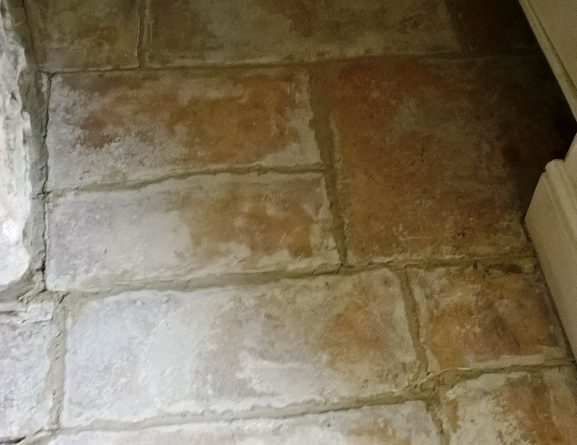George 3rd Flagstones Floor Renovated in a Cotswolds Cottage
Minchinhampton is an ancient market town located on a hilltop in the Cotswolds area of Gloucestershire, famous for being one of the UK’s areas of outstanding beauty. The town has a long history and many of the residents live in some truly picturesque and characterful cottages that date back to the 18th century and beyond.
I was recently contacted by a property owner in the village. She had just uncovered an original Flagstone tiled floor in her cottage, which dates to 1765. The floor had previously been covered by a wooden floor and the property owner was keen to see if I could restore it. We’ve had some fantastic success with restoring similar floors in the past, so I was more than happy to see what could be done.
I visited the property initially to conduct a test clean and check that I would be able to remove the copious wood adhesive left on the floor after the covering had been lifted. This test clean was successful, and the customer booked me in for complete the full restoration straight away.

Cleaning a Dirty Flagstone Tiled Floor
My first action in the process of restoring the floor was to mix a strong solution of two products – Tile Doctor NanoTech HBU and Tile Doctor Remove and Go. Remove and Go is designed to strip away any old sealer on the floor and dissolve any adhesive and paint stains, while NanoTech HBU is a potent cleaner which uses nano-sized particles to penetrate deep into the stone and eliminate ingrained dirt.
This solution was applied across the floor and left to dwell for 40 minutes. Then, using a poly-brush fitted to a floor buffing machine, I cleaned the floor and in doing so removed 85 percent of the ingrained dirt. To tackle the rest of the ingrained dirt, I spot cleaned the stubborn area using Tile Doctor Acid Gel in combination with a handheld steamer. Acid Gel is a concentrated mix of phosphoric and hydrochloric acids.
I also used a handheld buffing machine fitted with a Coarse 100 grit diamond encrusted pad to grind away any outstanding dirt and level off the surface of the tiles. When I was satisfied with the results of the cleaning process, my next operation was to replace all the missing grout on the floor. I did this using a Limestone grout, which was a good colour match for the Flagstone.
Sealing a Flagstone Tiled Floor
With the first day of work complete, I left the floor to dry out for the next three days. With the floor being particularly old, it was important to give it a long period to dry to help avoid any damp issues.
Upon returning to the property, I ran some quick damp tests to check the floor could be sealed. When satisfied that there was no excess moisture to deal with, I proceeded to seal the floor with three coats of Tile Doctor Seal and Go, leaving 30 minutes to dry between coats. This will give the floor robust protection against ingrained dirt along with the high-quality satin finish the customer had requested.

Seeing the result, the customer was really pleased with her floor. She had previously thought there was nothing that could be done to restore these old Flagstones, but with the right combination of products and cleaning methods I was able to achieve a fantastic restoration. Another satisfied customer.
Source: Sandstone Tile Cleaning and Restoration in Cotswolds
